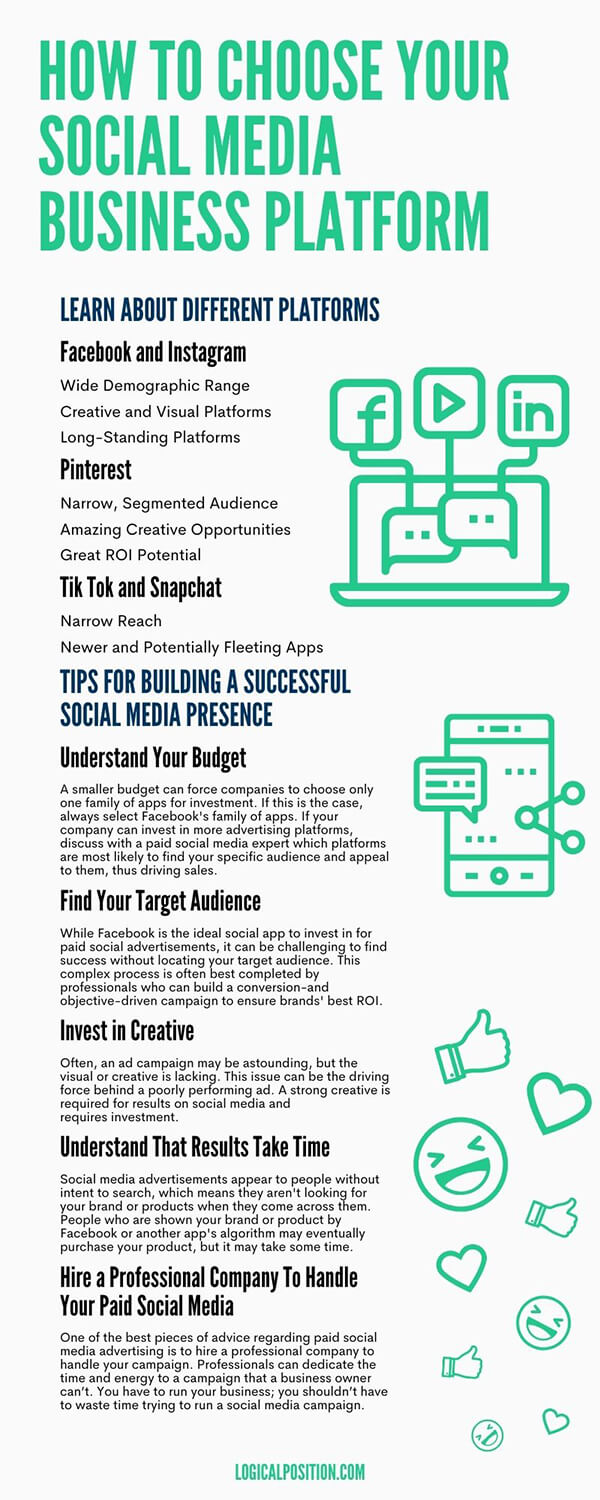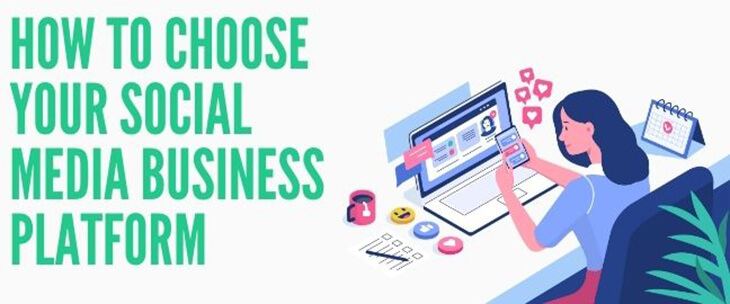Social media is the ruler of the internet in our current digital era. This is apparent because nearly everyone has at least one social media profile. Chances are you, the reader, have a social media profile or two as well. Nearly everyone having social media provides businesses with a unique opportunity to gain brand recognition and interact with current and potential customers. This audience is one that companies wouldn’t otherwise be able to reach.
Every business needs social media. It’s how customers and consumers communicate, discover new things, and make purchases. No matter your business type, there is great benefit to having multiple social media profiles. The plethora of platform choices poses a unique dilemma for companies worldwide: which platforms are right for my business, and do I need more than one? Explore the following methods on how to choose your social media business platform.
How Many Platforms is the “Right” Amount?
There are so many different social media platforms that are already very popular with the masses. New social media platforms also pop up every day. The frequent addition of platforms presents a predicament for businesses continually trying to keep up with the next “new thing” grasping the internet.
The real trick to determining if you should or shouldn’t focus on a specific platform is if your audience does or doesn’t use that app. Your company should not limit itself to just one social media platform. Only having one online business profile can hurt your chances of finding your highly segmented audience—which is how you increase your profits. There is no limit to how many social media profiles is the right amount, though it can be a waste of time and money to invest heavily in platforms that your market doesn’t use.
Learn About Different Platforms
With the handful of platforms available to users and businesses, it can be challenging to thoroughly understand each one. As algorithms continue to advance, it becomes more targeted to individuals, creating a blurred line of who a target user is. This is ideal for brands as you can better target a highly segmented audience. Below is a brief breakdown of the different platforms.
Facebook and Instagram
Facebook and Instagram are two apps that every business can benefit from by creating profiles and investing in paid social media advertisements.
Wide Demographic Range
The Facebook family of apps, including Instagram, Marketplace, and others, host one of the broadest ranges of demographics available, meaning your target audience is on it, no matter your business. This umbrella of apps hosts the most diverse range of demographics available on the web.
Creative and Visual Platforms
These are also platforms that provide a unique opportunity to be creative and visual with your ads. You need a strong creative for your advertisements, regardless of your demographic, to find success. These platforms require a compelling and robust creative to entice users to engage with your ad. This presents a unique opportunity to be creative and visual, really showcasing your creativity, products, and aesthetics.
Long-Standing Platforms
The Facebook family of apps is a platform that’s been around for over a decade. Its prominence isn’t wavering, and the apps continuously adapt. As new social media platforms introduce themselves as fading fads, the Facebook and Instagram apps adapt to include those fad features. These apps’ skillful implementation allows them to incorporate these features while maintaining their original, steady platforms that stand the test of time.
Pinterest is a platform that’s been around for a long time but struggled to find its niche market and develop a cohesive, social experience. As it finds its market, it is becoming a more prevalent app for businesses to invest in.
Narrow, Segmented Audience
While a segmented audience is ideal, there are a few downsides if your target audience doesn’t use the app. Pinterest users are mainly women between the ages of 25 and 50, so if this aligns with your audience, it can be an immeasurable asset. But, if it doesn’t, it may not be worth your time and investment.
Amazing Creative Opportunities
Pinterest is a community of creative, crafting, and online-shopping savvy individuals. This presents a unique opportunity for brands to flex their creative muscles and put out outstanding visuals to appeal to the users.
Great ROI Potential
Many Pinterest users end up planning purchases or purchasing items they see first on Pinterest. Pinterest bloggers, posters, and brands often use this visual platform to sample ways to utilize their products, leading to great conversion rates.
Tik Tok and Snapchat
Tik Tok and Snapchat are two wildly popular platforms within a very segmented market. These newer social media platforms are great for targeting a younger audience.
Narrow Reach
These platforms aren’t ideal for every business as the end-users are typically not of the age to purchase products. They appeal mostly to younger demographics such as teenagers and younger children. This can be a good platform for products the audience may tell parents or guardians about as gift items for birthdays and holidays.
Newer and Potentially Fleeting Apps
These apps are not as established as Facebook or Instagram yet. For brands investing heavily in them, they are gambling that the apps will stand the test of time. For brands that need long-term results, these apps may not be the right strategy.
Tips for Building a Successful Social Media Presence
While essential for businesses in every field, social media can be challenging to navigate, especially for businesses run by non-digital natives, as most are. When investing in paid social media advertisements, there are many features and considerations to keep in mind. Simply throwing an add up across all platforms for a random audience won’t yield results—you need a strategy. Check out some expert tips on building a successful social media business campaign.
Understand Your Budget
While larger companies often advertise across platforms, smaller brands and newer companies may have smaller budgets. A smaller budget can force companies to choose only one family of apps for investment. If this is the case, always select Facebook’s family of apps. Your target market is using these apps. Your company’s most significant task when choosing to invest in paid social through Facebook’s umbrella is finding your segmented audience.
If your company can invest in more advertising platforms, discuss with a paid social media expert which platforms are most likely to find your specific audience and appeal to them, thus driving sales.
Find Your Target Audience
While Facebook is the ideal social app to invest in for paid social advertisements, it can be challenging to find success without locating your target audience. This platform isn’t easy to use. For success, you need to pay close attention to the wide range of Facebook options and create a strong plan and campaign.
This complex process is often best completed by professionals who can build a conversion-and objective-driven campaign to ensure brands’ best ROI.
Invest in Creative
A pitfall many brands fall into is trying to do everything themselves. Often, an ad campaign may be astounding, but the visual or creative is lacking. This issue can be the driving force behind a poorly performing ad. A strong creative is required for results on social media and requires investment.
Understand That Results Take Time
Social media is not the space for instant gratification on your ads. People are scrolling through their social media feeds, looking for content from friends and family. Your advertisement interrupts their scroll.
Social media advertisements appear to people without intent to search, which means they aren’t looking for your brand or products when they come across them. People who are shown your brand or product by Facebook or another app’s algorithm may eventually purchase your product, but it may take some time.
The process of a social media conversion typically looks like this:
- A person is scrolling through their feed and sees your brand’s advertisement.
- The person may interact with the ad or scroll on with a new awareness of your product or brand.
- The person forgets about your brand or product.
- Another advertisement retargets the person for your brand or product.
- The person searches your brand or product either through clicking the ad or a different search engine search.
- The person contemplates the purchase.
- The person makes a purchase.
The vital thing to note about this process is although the interest and conversion began through social media, the last click may not show this. It’s crucial to develop a solid understanding of Facebook’s 28-day attribution window to picture the actual conversions driven by paid social media entirely.
Hire a Professional Company To Handle Your Paid Social Media
One of the best pieces of advice regarding paid social media advertising is to hire a professional company to handle your campaign. Professionals can dedicate the time and energy to a campaign that a business owner can’t. You have to run your business; you shouldn’t have to waste time trying to run a social media campaign.

With Logical Position, you get to enjoy a team of individuals that focus on each bucket of the overall strategy. We provide you with a dedicated account manager, a specialist to hone in on your strategy and goals. We successfully provide you with a full-funneled marketing approach. Our team even provides high-quality advertising copy and strong creative.
As a Premier Global Facebook Partner, we are recognized by Facebook for being one of the best agencies globally and work directly with a Facebook Partner Manager for our strategies. Facebook provides us with resources to ensure we provide top quality campaigns.
Contact us today to discover what a Logical Position conversion-driven paid social media advertising campaign can do for your brand.




